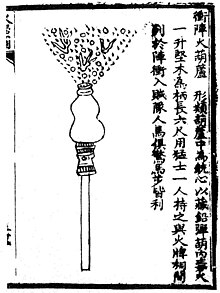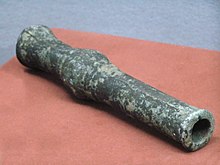This article has an unclear citation style. (May 2015) |


The history of the firearm begins in 10th-century China, when tubes containing gunpowder projectiles were mounted on spears to make portable fire lances.[1] Over the following centuries, the design evolved into various types, including portable firearms such as flintlocks and blunderbusses, and fixed cannons, and by the 15th century the technology had spread through all of Eurasia. Firearms were instrumental in the fall of the Byzantine Empire and the establishment of European colonization in the Americas, Africa, and Oceania. The 19th and 20th centuries saw an acceleration in this evolution, with the introduction of the magazine, belt-fed weapons, metal cartridges, rifled barrels, and automatic firearms, including machine guns.
Older firearms typically used black powder as a propellant, but modern firearms use smokeless powder or other propellants.
There are reports of some sort of incendiary chemical weapon, the Greek fire, used by the Eastern Roman Empire (Byzantine Empire) from the 7th through the 14th centuries, which may have been delivered through grenades and/or by some kind of flamethrower. However, its nature is still being debated, and it does not seem related to ancient Chinese or modern firearms.
- ^ Helaine Selin (1997). Encyclopaedia of the History of Science, Technology, and Medicine in Non-Western Cultures. Springer. p. 389. ISBN 978-0-7923-4066-9. Archived from the original on 9 October 2013. Retrieved 30 July 2013.